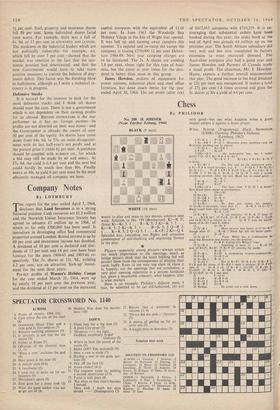Chess
By PHILIDOR
No. 200 H. JOHNER (Neue Zfireher Zeitung, 1944)
BLACK (9 men) WHITE (10 men) WHITE to play and mate in two moves; solution next week. Solution to No. 199 (Brotherton): Kt-K 2l, threat Kt-Kt 3. 1 . . . R-K 5; 2 Kt-K 7. I. Kt-K 5; 2 Kt-K 3. 1 . . . B-K 5; 2 Q-R 3. 1 . . . K-K 5; 2 Q-Q 3. 1 . . . K X P; 2 Kt-Q 4. Splendid key, conceding two flights and attractive combination of self-blocking and unpinning themes in 'the play. • Players-especially young players-always attach too much importance to the openings, much as bridge players think that the latest bidding fad will protect them fromthe consequences of playing their cards badly. Even in the very top class of chess it is, happily, not the openings that are conclusive; a very poor opening repertoire is a serious handicap but, given a reasonable armoury, what happens later
is what matters.
Here is an example. Philidor's defence must, 1 fear, be admitted to be (a) old-fashioned, (b) not
very good-but see what happens when a great master adopts it against a lesser player.
While, Butrox (Yugoslavia). Black. BRONSTEIN (USSR). Opening, Philidor's Defence. (Lemberg, 1962) t P-K 4 P-K 4 •
2 Kt-KB 3 P-Q 3. Bronstein plays anything-and by Bronstein anything can be played. 3 P-Q 4 Kt-KB 3 4 P x P KtxP 5 ()Kt-Q 2. . . the fashionable line. but I rather prefer 5 Q-Q 5. Kt-B 4; 6 B-Kt 5. 5 Kt-B 4. 5 . . . KtxKt; 6 BxKt, B-K 2 is better.
6 Kt-Kt 3 . The first step on the downward path. 6 Kt-B 4 is much 'stronger, e.g.. 6 . . . P-Q 4: 7 B-Kt 51. Q-Q 2(7 . . P-B 3; 8 P x P. P X P; 9 Kt-K 51); 8 Kt-K 3. P-QB 3; 9 Kt-Q 4, B-K 2; 10 Q-13 5 with a strong attacking position. After the text, Black has an equal game.
6 . . . Kt-K3 7 B-K 3 Kt-B3
98 QPKxtP-Q 4 .13.xP . This loses time. 9 Q-Q 2 is better.• Now Back draws ahead in development. • 10 Kt x Kt 0Q-Ki0x Kt 9 .
II B-QB 4 0-1331 12 P-QB 3 Kt x Kt 13 13 x Kt? • . . . He does not realise his danger. 13 Ox Kt ts necessary, when after 13 . . . B-K 4; 14 Q-4.) Black would have only a slight pull. 13 . . . R-K 1 ch
K-B I . .. A sad necessity. 14 B-K 3? loses IA 14 . . . R x B chl; 15 P X R. Q-R .ch; 16 P-Kt 3, Q xli
and 14 13-K 2 is refuted by 14 . . . Q-R 51 with the double threat of-B-Kt 5 and P-QB 4. 14 . . Q-Kt 4 • 15 1 . . More natural, and better, is 15 Q-13 though after 15 . . . R-K 2 Black has still the better game.
15 . . . 0-ES
16 IIP-Q 1? . . . Fatal. White has a combination in • mind bat Bronstein sees further into the position.
16 -P-B 4! Falling into White's'trap.' 17 0-211 4 . . . Intending to meet 17 . . . R-Q 17 With 18 litxPl, Bx111?; 19 BXP ch' winning the queen.
17 . R-K 5! 18 P-B 3 P x B1 A devastating counter-comblnation. 19 PxR 0-B 5 cti 20 K-KL 1 B-K 3 21 R-Q 1 . . . Not 21 B X fl?. Q-K 6 eh; 22 K-B I. PxB and the threat of R-K13•1 mate is decisive. If 21 PXP then 21 . . Q-K 6 ch; 22 .K-B I, QXQP; 23 13-Kt 5, QXKtP; 23 11.-K 1. B-QB 4; 24 B-K 2. P-QKt 25 Q X KtP,' Q-Q Sand wins, 21 . . . P-06! 22 R xP B--B 4 ch 23 R-Q 4 0-8 8 eh 24 K-B 2 QxR
' 25 Resigns . . . He Comes out a rook down.


































 Previous page
Previous page